News & Updates
Lotus - A trusted name in family travel
Anhui Province
Anhui Province, also known as Wan for short, is located in southeast China, on the lower reaches of the Yangtze River in southeast China. Its name has the meaning of “Peaceful Beauty”. More than two-thirds of this landlocked province is composed of mountains and hills, with the highest elevations in 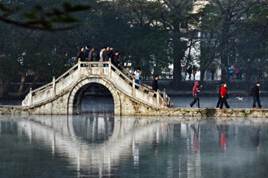 the
the 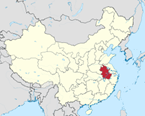 southwest. Geographically, it is one of the country’s smallest provinces. Chinese refer to Anhui as a "big agricultural province" (农业大省). This is considered a euphemism for a "very poor" area; people have referred to Anhui as the "Appalachia of China." There is significant regional disparity in the province, with most of the wealth being concentrated in industrial regions close to the Yangtze River, such as Hefei, Wuhu, and Ma'anshan. One of the most famous Anhui-based corporations is the automobile company Chery, based in Wuhu.
southwest. Geographically, it is one of the country’s smallest provinces. Chinese refer to Anhui as a "big agricultural province" (农业大省). This is considered a euphemism for a "very poor" area; people have referred to Anhui as the "Appalachia of China." There is significant regional disparity in the province, with most of the wealth being concentrated in industrial regions close to the Yangtze River, such as Hefei, Wuhu, and Ma'anshan. One of the most famous Anhui-based corporations is the automobile company Chery, based in Wuhu.
People
Han Chinese make up roughly 99% of Anhui’s population of 68 million. There is a small number of Hui and She minority groups. Most of the inhabitants live on the plains near the Huai River in northern Anhui, or near the Yangtze River in the south. The most dominant religions are Buddhism and Taoism, though Anhui has a larger Christian population than most other Chinese provinces. Anhui is also known for having a highly unbalanced gender ratio. According to a study published in the British Medical Journal, in the 1-4 age group, there are 138 boys for every 100 girls, making it among the most gender unbalanced of provinces in all of China.
Cultural Contributions
- Cooking
 Anhui cuisine is one of the eight great traditions of Chinese cuisine and is known for its use of wild game and herbs, which is considered herbal medicinal cuisine and has fairly
Anhui cuisine is one of the eight great traditions of Chinese cuisine and is known for its use of wild game and herbs, which is considered herbal medicinal cuisine and has fairly 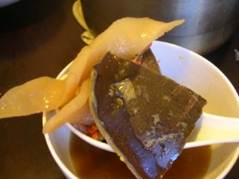 elaborate methods of preparation. The combination of the traditional herbal medicine and fresh culinary ingredients provides a highly nutritious diet. Popular dishes include pork in lotus and lily seeds broth, Huangshan braised pigeon, salted fresh trout and stewed Snapper. Besides the nutritious medicinal feast, tourist can also try local favorites, such as fermented fish, stuffed tofu, Wuwei smoked duck, bamboo shoots and soft-shelled turtle soup. Dishes are typically stewed or braised to exact temperatures and served in generous portions.
elaborate methods of preparation. The combination of the traditional herbal medicine and fresh culinary ingredients provides a highly nutritious diet. Popular dishes include pork in lotus and lily seeds broth, Huangshan braised pigeon, salted fresh trout and stewed Snapper. Besides the nutritious medicinal feast, tourist can also try local favorites, such as fermented fish, stuffed tofu, Wuwei smoked duck, bamboo shoots and soft-shelled turtle soup. Dishes are typically stewed or braised to exact temperatures and served in generous portions.
- Calligraphy
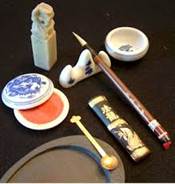
The province is famous for its production of the "four treasures of the study": xuan paper, ink slabs, ink sticks and writing brushes. The cities of Xuancheng and Huangshan are revered for producing Xuan Paper and Hui Ink, respectively. These tools are considered the best types of paper and ink for Chinese calligraphy. She County is famous for the She Ink stone, and is one of the most preferred types of ink stone, which is required in traditional calligraphy. And, the best writing brushes are produced in Xuancheng, making Anhui the home of all important calligraphy tools.
- Opera
 Huangmei Opera, and Huizhou Opera are considered two of the most famous traditional operas in China, both of which originated in Anhui. As a local drama in Anhui Province, Huangmei Opera originated during the 18th century, during a time of artistic flourishing. Over the past 200 years, Huangmei Opera has developed quite a number of repertoires much loved by people. In particular, Anhui Provincial Huangmei Opera Troupe's "The Heavenly Maid and the Mortal" ushered in a new era for the opera in its development. Huizhou Opera was developed locally and modified in the late 18th century and blended into what has become the genesis for what is known now as Peking Opera. This mostly rural province has made strong contributions to the country and the world, as now the opera has grown into a professional performance piece in both rural and urban areas and has become a recreational activity for millions of people.
Huangmei Opera, and Huizhou Opera are considered two of the most famous traditional operas in China, both of which originated in Anhui. As a local drama in Anhui Province, Huangmei Opera originated during the 18th century, during a time of artistic flourishing. Over the past 200 years, Huangmei Opera has developed quite a number of repertoires much loved by people. In particular, Anhui Provincial Huangmei Opera Troupe's "The Heavenly Maid and the Mortal" ushered in a new era for the opera in its development. Huizhou Opera was developed locally and modified in the late 18th century and blended into what has become the genesis for what is known now as Peking Opera. This mostly rural province has made strong contributions to the country and the world, as now the opera has grown into a professional performance piece in both rural and urban areas and has become a recreational activity for millions of people.
 Places to See
Places to See
Mount Huangshan is rated as the "No. 1 Mountain Under Heaven" and is undoubtedly one of the most famous mountains in China. Originally known as Mt. Yishan, in 747AD it was renamed Mt. Huangshan in recognition of the legendary Huang Di, the reputed ancestor of all Han people. In Chinese mythology, he is said to have made his magic pills for immortality here. It is also a site favored by poets and artists because of its great beauty, with towering pines, precipitous stones and an ocean of clouds and hot springs. These are known as the mountain’s "four wonders".
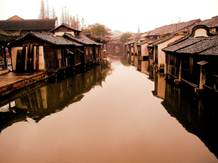 In addition to the beautiful mountain scenery, the nearby well-preserved ancient villages are fascinating places to visit. Hongcun Village, regarded as the most beautiful village among them all, is an ancient village with hundreds of years of history. It was established in 1131, during the Southern Song Dynasty. It was the main village on the only road between Yixian and the capital, and catered to en route at that time. Many of the houses in the village have kept their original appearance. The village contains the best- preserved ancient antique residences built in the "Hui" style. Built with white walls and black tiles, these houses usually have large courtyards and private gardens, and at the same time showing their fine brick, wood and stone carvings. The village became a UNESCO Cultural Heritage Site in 2000 and was one of the shooting sites for the martial arts movie "Crouching Tiger, Hidden Dragon".
In addition to the beautiful mountain scenery, the nearby well-preserved ancient villages are fascinating places to visit. Hongcun Village, regarded as the most beautiful village among them all, is an ancient village with hundreds of years of history. It was established in 1131, during the Southern Song Dynasty. It was the main village on the only road between Yixian and the capital, and catered to en route at that time. Many of the houses in the village have kept their original appearance. The village contains the best- preserved ancient antique residences built in the "Hui" style. Built with white walls and black tiles, these houses usually have large courtyards and private gardens, and at the same time showing their fine brick, wood and stone carvings. The village became a UNESCO Cultural Heritage Site in 2000 and was one of the shooting sites for the martial arts movie "Crouching Tiger, Hidden Dragon".
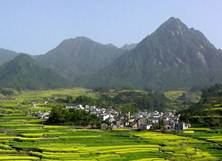 Shexian is a county located at the southern foot of Huangshan Mountain and in the upper reaches of the Xin’an River and is surrounded by spectacular mountains and streams. Tangyue, is known as the “The Town of the Arches”, and is the best place to see the residential architecture and memorial arches from the Ming and Qing dynasties. There are thousands of arches in this area; typically made of fine wood or stone, often created as a memorial, though some were created simply for decoration. Besides the arches, there are many elegantly
Shexian is a county located at the southern foot of Huangshan Mountain and in the upper reaches of the Xin’an River and is surrounded by spectacular mountains and streams. Tangyue, is known as the “The Town of the Arches”, and is the best place to see the residential architecture and memorial arches from the Ming and Qing dynasties. There are thousands of arches in this area; typically made of fine wood or stone, often created as a memorial, though some were created simply for decoration. Besides the arches, there are many elegantly  constructed ancient residential houses and ancestral temples, with features unique to this region. Visiting this area will provide immense insight into the social culture of China’s ancient feudal society. These historical sites are described as “the gems of ancient Chinese architecture”.
constructed ancient residential houses and ancestral temples, with features unique to this region. Visiting this area will provide immense insight into the social culture of China’s ancient feudal society. These historical sites are described as “the gems of ancient Chinese architecture”.
Also located in Anhui is Mount Jihua, which is one of the four famous Buddhist mountain sanctuaries in China. It has all its major temples and attractions located within 100 square km, so it is convenient to visit many of the sacred sites during a visit.
Tunxi is also an interesting city to visit. It originally emerged during the Southern Song Dynasty. The “Old Street” in Tunxi is paved with bluestones and has buildings that reflect the unique Anhui architecture style. Souvenir stores sell local specialties, such as Shexian County’s ink slabs, Mount Huangshan's maojian tea and the Hukaiwen-brand Anhui ink sticks can be found on Ale street.
The best time to visit these scenic areas is in autumn (September, October, and November) and spring (April, May and June). However, the snow scenery of Huangshan is absolutely fascinating so if you enjoy the snow, it can be a great to come during the winter.
Transport & Travel
 Lotus Travel has assisted many families travel to Anhui province to adopt children and is pleased to assist families make a return trip to learn more about this province, rich in beauty and natural resources. It is a lovely province to explore and spend time getting to appreciate the “real” China as you spend time exploring parts of China less visited by tourist groups. We can arrange air transportation into Anhui and also the rail transport system has become a significant presence here as well. The province has the largest rail system in eastern China, with more than 2500km of railway. The three high- speed lines include Beijing-Shanghai High-Speed Railway; Hefei–Wuhan Passenger Railway; and Hefei–Nanjing Passenger Railway. Anhui can be a great place to explore and learn more in-depth what China is like when you travel here. Come to China with Lotus Travel and explore Anhui!!! Email us at louie@lotustours.net to get started.
Lotus Travel has assisted many families travel to Anhui province to adopt children and is pleased to assist families make a return trip to learn more about this province, rich in beauty and natural resources. It is a lovely province to explore and spend time getting to appreciate the “real” China as you spend time exploring parts of China less visited by tourist groups. We can arrange air transportation into Anhui and also the rail transport system has become a significant presence here as well. The province has the largest rail system in eastern China, with more than 2500km of railway. The three high- speed lines include Beijing-Shanghai High-Speed Railway; Hefei–Wuhan Passenger Railway; and Hefei–Nanjing Passenger Railway. Anhui can be a great place to explore and learn more in-depth what China is like when you travel here. Come to China with Lotus Travel and explore Anhui!!! Email us at louie@lotustours.net to get started.